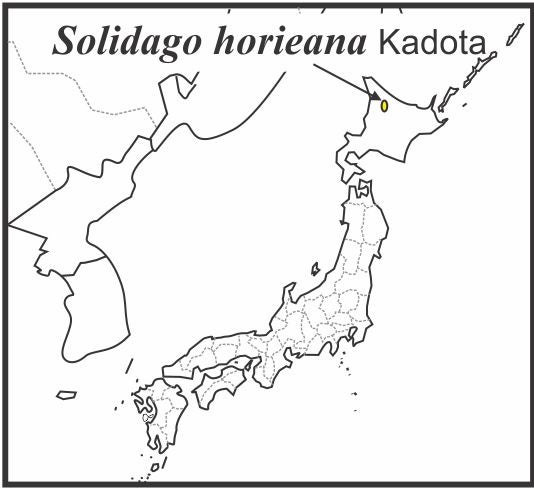Horie Goldenrod

Solidago horieana Kadota is a rare endemic growing on serpentine rocks along streams in northern Hokkaido, Japan. It was described in 2008. It is named for its discoverer K. Horie who first found it. The plants have robust strong rootstocks that anchor individuals to rocks during flash floods. Lower stem leaves are petiolate with narrowly lanceolate blades that taper at the bases. Mid and upper stem leaves are widely spaced, somewhat reduced, narrowly lanceolate and serrate. Showy heads are borne in open arrays. The species is both a rheophyte and serpentinophyte. It is readily distinguished from the much more common and widely distributed on Hokkaida Is. S. kurilensis (syn. S. nipponica) , which has larger broader truncate basal and lower stem leaves and usually has heads in flat-topped corymbiforms arrays. Solidago horieana has achene fruit bodies with hairs denser distally. The species is similar to S. decurrens which have smaller heads. Solidago horieana is a rheophyte like S. yokusaiana, but the habitats differ and the ranges of the two species are allopatric and the two are very morphologically distinct.
The species is diploid.
A single specimen of S. horieana was included a posteriori in the multivariate study of S. ser. Solidago by Semple et al. (2020) and was assigned to S. kurilensis with 100% probability, although leaf and inflorescence traits do not fit into S. kurilensis.
Shota Sakaguchi is thanked for providing digital images.
Kadota , Y. 2008 . Solidago horieana (Asteraceae), a new species from Hokkaido, northern Japan. J. Japanese Botany 83 : 233 – 238.
Semple, J.C., Y. Ma, L. Tong, and M. Sorour. 2020. A multivariate morphometric analysis of Solidago sect. Solidago and S. sect. Multiradiatae (Asteraceae: Astereae). Phytoneuron 2020-38: 1–59.
Last revised 17 May 2025 by J.C. Semple
© 2025 J.C. Semple. Field photographs provided by Shota Sakaguchi
1-6. Solidago horieana, Hokkaido, Japan. 1-3. Habitat and habits, inflorescences, Images by Shota Sakaguchi. 4-5. Two shoots and heads, Kenji Horie s.n. TNS. 6. Fruit, Kadota 073122 TNS.











